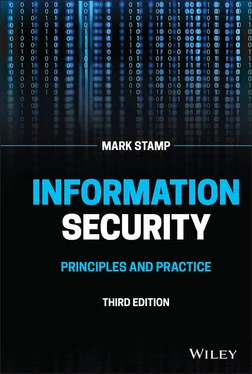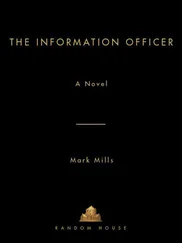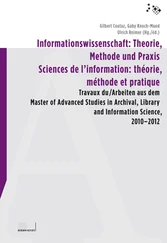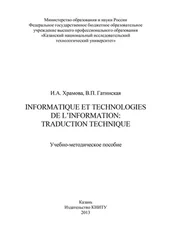Mark Stamp - Information Security
Здесь есть возможность читать онлайн «Mark Stamp - Information Security» — ознакомительный отрывок электронной книги совершенно бесплатно, а после прочтения отрывка купить полную версию. В некоторых случаях можно слушать аудио, скачать через торрент в формате fb2 и присутствует краткое содержание. Жанр: unrecognised, на английском языке. Описание произведения, (предисловие) а так же отзывы посетителей доступны на портале библиотеки ЛибКат.
- Название:Information Security
- Автор:
- Жанр:
- Год:неизвестен
- ISBN:нет данных
- Рейтинг книги:3 / 5. Голосов: 1
-
Избранное:Добавить в избранное
- Отзывы:
-
Ваша оценка:
- 60
- 1
- 2
- 3
- 4
- 5
Information Security: краткое содержание, описание и аннотация
Предлагаем к чтению аннотацию, описание, краткое содержание или предисловие (зависит от того, что написал сам автор книги «Information Security»). Если вы не нашли необходимую информацию о книге — напишите в комментариях, мы постараемся отыскать её.
Provides systematic guidance on meeting the information security challenges of the 21st century, featuring newly revised material throughout Information Security: Principles and Practice
Information Security
Information Security: Principles and Practice, Third Edition
Information Security — читать онлайн ознакомительный отрывок
Ниже представлен текст книги, разбитый по страницам. Система сохранения места последней прочитанной страницы, позволяет с удобством читать онлайн бесплатно книгу «Information Security», без необходимости каждый раз заново искать на чём Вы остановились. Поставьте закладку, и сможете в любой момент перейти на страницу, на которой закончили чтение.
Интервал:
Закладка:
At the height of World War I in 1917, the German Foreign Minister, Arthur Zimmermann, sent an encrypted telegram to the German ambassador in Mexico City. The ciphertext message, a reproduction of which appears in Figure 2.4[95], was intercepted by the British. At the time, the British, French, and Russians were at war with Germany, while the United States was striving to remain neutral.
The Russians had recovered a damaged version of the German codebook, and the partial codebook had been passed on to the British. Through painstaking analysis, the British were able to fill in the gaps in the codebook, so that by the time they obtained the Zimmermann Telegram, they could decrypt it. The telegram stated that the German government was planning to begin unrestricted submarine warfare and had concluded that this would likely lead to war with the United States. As a result, Zimmermann told his ambassador to Mexico that Germany should try to recruit Mexico as an ally to fight against the United States. Among other incentives, Mexico was to “reconquer the lost territory in Texas, New Mexico and Arizona.″ When the Zimmermann Telegram was released in the U.S., public opinion turned sharply against Germany and, after the sinking of the Lusitania, the United States declared war.
The British were initially hesitant to release the Zimmermann Telegram since they feared that the Germans would realize that their cipher was broken and, presumably, stop using it. After decrypting the Zimmermann Telegram, the British took a closer look at other intercepted messages that had been sent at about the same time. To their amazement, they found that a variant of the incendiary telegram had been sent unencrypted. 7 The British subsequently released a version of the Zimmermann Telegram that closely matched this unencrypted version. As the British hoped, the Germans concluded that their codebook had not been compromised and continued to use it for sensitive messages throughout the war.
2.4.3 Project VENONA
The so‐called VENONA project [130] provides an interesting example of a real‐world use of the one‐time pad. In the 1930s and 1940s, spies from the Soviet Union who entered the United States brought with them one‐time pad keys. When it was time to report back to their handlers in Moscow, these spies used the one‐time pads to encrypt their messages, which were then sent. These spies were extremely successful, and their messages dealt with the most sensitive U.S. government secrets of the time. In particular, the development of the first atomic bomb was a focus of much of the espionage. The Rosenbergs, Alger Hiss, and many other well‐known traitors—and many who were never identified—figure prominently in VENONA messages.
The Soviet spies were well trained and never reused the key, yet many of the intercepted ciphertext messages were eventually decrypted by American cryptanalysts. How can that be, given that the one‐time pad is provably secure? In fact, there was a flaw in the method used to generate the pads, so that, in effect, long stretches of the keys were repeated. As a result, many messages were in depth, which allowed for successful cryptanalysis of about 3000 VENONA messages.
Part of one interesting VENONA decrypt is given in Table 2.4. This message refers to David Greenglass and his wife Ruth. LIBERAL is Julius Rosenberg who (along with his wife Ethyl) was eventually executed for his role in nuclear espionage. 8 The Soviet codename for the atomic bomb was, appropriately, ENORMOUS. For any World War II‐era history buff, the VENONA decrypts at [130] make for fascinating reading.
Table 2.4 VENONA decrypt of message of 21 September 1944
[C% Ruth] learned that her husband [v] was called up by the army |
|---|
but he was not sent to the front. He is a mechanical engineer |
and is now working at the ENORMOUS [ENORMOZ] [vi] plant in |
SANTA FE, New Mexico. |
45 groups unrecoverable] |
detain VOLOK [vii] who is working in a plant on ENORMOUS. He is a |
FELLOWCOUNTRYMAN [ZEMLYaK] [viii]. Yesterday he learned that |
they had dismissed him from his work. His active work in |
progressive organizations in the past was cause of his dismissal. |
In the FELLOWCOUNTRYMAN line LIBERAL is in touch with CHESTER [ix]. |
They meet once a month for the payment of dues. CHESTER is |
interested in whether we are satisfied with the collaboration and |
whether there are not any misunderstandings. He does not inquire |
about specific items of work [KONKRETNAYa RABOTA]. In as much |
as CHESTER knows about the role of LIBERALś group we beg consent |
to ask C. through LIBERAL about leads from among people who are |
working on ENOURMOUS and in other technical fields. |
2.5 Modern Crypto History
Throughout the 20th century, cryptography played an important role in major world events. Late in the 20th century, cryptography became a critical technology for commercial and business communications as well, and it remains so today.
The Zimmermann Telegram is one of the first examples from the last century of the role that cryptanalysis can play in political and military affairs. In this section, we mention a few other historical highlights from the past century, with an eye towards the modern development of cryptography as a scientific discipline. For more on the history of cryptography, the indispensable source is Kahnś book [61].
In 1929, Secretary of State Henry L. Stimson ended the U.S. governmentś official cryptanalytic activity, justifying his actions with the immortal line, “Gentlemen do not read each otherś mail″ [115]. This would prove to be a costly mistake in the run‐up to the attack on Pearl Harbor.
Prior to the Japanese attack of 7 December 1941, the United States had restarted its cryptanalytic programs. The successes of allied cryptanalysts during the World War II era were remarkable, and this period is often seen as the golden age of cryptanalysis. Virtually all significant Axis cryptosystems were broken by the Allies and the value of the intelligence obtained from these systems is difficult to overestimate.
In the Pacific theater, the so‐called “Purple cipher″ was used for high level Japanese government communication. This cipher was broken by American cryptanalysts before the attack on Pearl Harbor, but the intelligence gained (code named Magic) provided no clear indication of the impending attack. Japanś Imperial Navy used a cipher known as JN‐25, which was also broken by the Americans. The intelligence from JN‐25 was almost certainly decisive in the extended battle of Coral Sea and Midway, where an inferior American force was able to to halt the advance of the Japanese in the Pacific for the first time. The Japanese Imperial Navy was never able to recover from the losses inflicted during this crucial battle.
In Europe, the German Enigma cipher (code named Ultra) was a major source of intelligence for the Allies during the war. It is often claimed that the Ultra intelligence was so valuable that Churchill decided not to inform the British city of Coventry of an impending attack by the German Luftwaffe, since the primary source of information on the attack came from Enigma decrypts [44]. Churchill was supposedly concerned that a warning might tip off the Germans that their cipher had been broken. That this did not occur has been well documented. Nevertheless, it was a challenge to utilize valuable Ultra intelligence without giving away the fact that the Enigma had been broken [12].
Читать дальшеИнтервал:
Закладка:
Похожие книги на «Information Security»
Представляем Вашему вниманию похожие книги на «Information Security» списком для выбора. Мы отобрали схожую по названию и смыслу литературу в надежде предоставить читателям больше вариантов отыскать новые, интересные, ещё непрочитанные произведения.
Обсуждение, отзывы о книге «Information Security» и просто собственные мнения читателей. Оставьте ваши комментарии, напишите, что Вы думаете о произведении, его смысле или главных героях. Укажите что конкретно понравилось, а что нет, и почему Вы так считаете.











